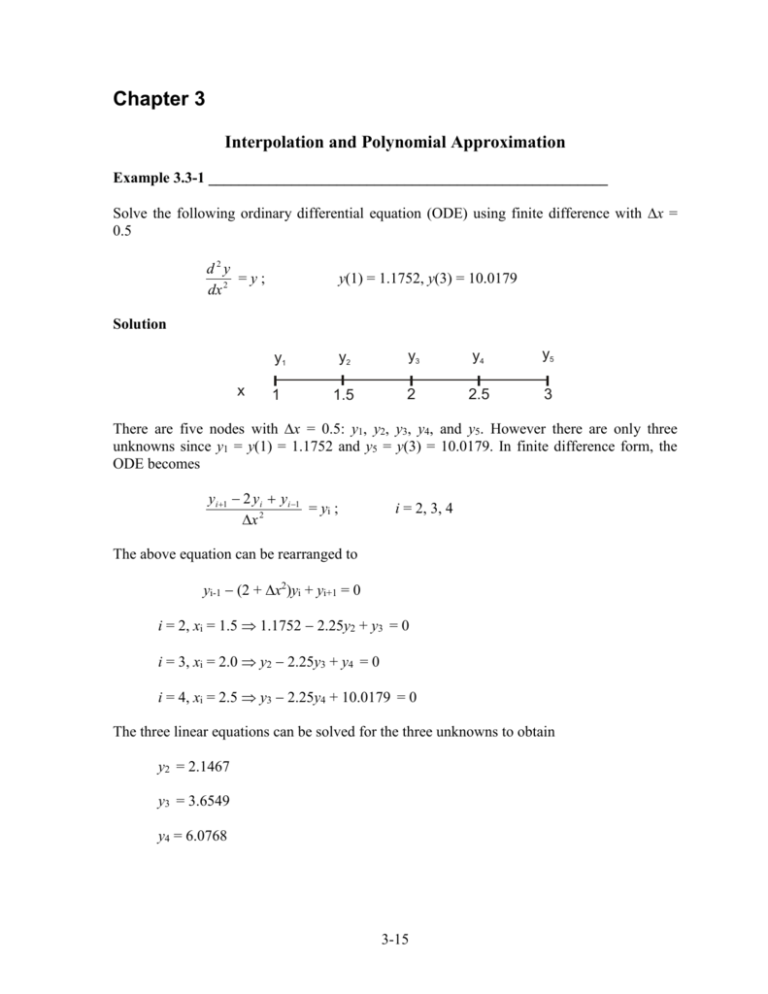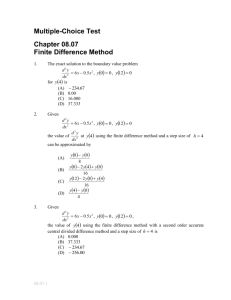Ch3-3e
advertisement

Chapter 3 Interpolation and Polynomial Approximation Example 3.3-1 _____________________________________________________ Solve the following ordinary differential equation (ODE) using finite difference with x = 0.5 d2y =y; dx 2 y(1) = 1.1752, y(3) = 10.0179 Solution x y1 y2 y3 y4 y5 1 1.5 2 2.5 3 There are five nodes with x = 0.5: y1, y2, y3, y4, and y5. However there are only three unknowns since y1 = y(1) = 1.1752 and y5 = y(3) = 10.0179. In finite difference form, the ODE becomes yi 1 2 yi yi 1 = yi ; x 2 i = 2, 3, 4 The above equation can be rearranged to yi-1 (2 + x2)yi + yi+1 = 0 i = 2, xi = 1.5 1.1752 2.25y2 + y3 = 0 i = 3, xi = 2.0 y2 2.25y3 + y4 = 0 i = 4, xi = 2.5 y3 2.25y4 + 10.0179 = 0 The three linear equations can be solved for the three unknowns to obtain y2 = 2.1467 y3 = 3.6549 y4 = 6.0768 3-15 Example 3.3-2 _____________________________________________________ Solve the following ordinary differential equation (ODE) using finite difference with x = 0.25 d2y = 4y ; dx 2 y(0) = 1, 4 dy = y at x = 1.0 dx Solution x y1 y2 y3 y4 y5 0 0.25 0.50 0.75 1.00 y6 There are five nodes with x = 0.25: y1, y2, y3, y4, and y5. The first node is given since y1 = y(0) = 1. However there is one more extra node on the right y6 due to the derivative boundary condition at x = 1.0. In finite difference form, the ODE becomes yi 1 2 yi yi 1 = 4yi ; x 2 i = 2, 3, 4, 5 The above equation can be rearranged to yi-1 (2 + 4x2)yi + yi+1 = 0 i = 2, x = 0.25 1.0 2.25y2 + y3 = 0 i = 3, x = 0.50 y2 2.25y3 + y4 = 0 i = 4, x = 0.75 y3 2.25y4 + y5 = 0 i = 5, x = 1.00 y4 2.25y5 + y6 = 0 y6 can be eliminated by using the boundary condition 4 4 dy = y at x = 1.0 dx y6 y4 = y5 y6 = 0.125y5 + y4 2 0.25 The equation at node 5 becomes 2y4 2.375y5 = 0 The four linear equations can be solved for the four unknowns to obtain y2 0.6248 y3 0.4058 y4 0.2822 3-16 y5 0.2427 Example 3.3-3 _____________________________________________________ Solve the following ordinary differential equation (ODE) using finite difference with x = 0.25 dy d2y x + x2y = x3 ; 2 dx dx y+ dy dy = 1 at x = 0, y + = 2 at x = 1 dx dx Solution y0 x y1 y2 y3 y4 y5 0 0.25 0.50 0.75 1.00 y6 There are five nodes with x = 0.25: y1, y2, y3, y4, and y5. However there are two more extra nodes y0 and y6 due to the derivative boundary conditions. In finite difference form, the ODE becomes yi 1 2 yi yi 1 y yi 1 xi i 1 + xi2yi = xi3 ; 2 x 2x i = 1, 2, 3, 4, 5 The above equation can be rearranged to (2 + xi x)yi-1 + (2x2xi2 4)yi + (2 xi x)yi+1 = 2x2xi3 i = 1, xi = 0 2y0 4y1 + 2y2 = 0 y0 can be replaced with y1 and y2 from the boundary condition at x = 0. y1 + y2 y0 = 1 2y0 = y1 + 2y2 1 3y1 + 4y2 = 1 2 x i = 2, 3, 4 (2 + xi x)yi-1 + (2x2xi2 4)yi + (2 xi x)yi+1 = 2x2xi3 i = 5, xi = 1.00 2.25y4 3.875y5 + 1.75y6 = 0.125 y6 can be replaced with y4 and y5 from the boundary condition at x = 1. y5 + y6 y4 = 2 y6 = y4 0.5y5 + 1 2 x 2.25y4 3.875y5 + 1.75(y4 0.5y5 + 1) = 0.125 The five linear equations can be solved for the five unknowns to obtain y1 0.41371 y2 0.56028 y3 0.71506 3-17 y4 0.88689 y5 1.08896











